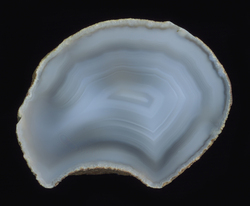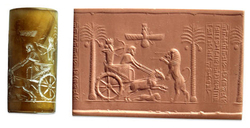Welcome to the first Iranian agates page of Maziar Nazari
Agate in ancient Persia
Iran has long had a reputation in ancient world as a source of good quality agates, and owes this renown principally to several extensive volcanic provinces, which extended vast districts of this country.Archeological researches on ancient founds in early human settle sites and ancient tombs, in prehistoric age, shows this fact that agate, chalcedony and jasper used not only for making stony blades and instruments like arrowhead, but also used as semiprecious stone for making beads and pendants. Some of these founds age go back to 6th millennium BC in age.
During historical age (after 1st millennium BC) agate, chalcedony and jasper used for making masterpieces gemstone and also roll and seal stamps, stock of dagger and sward and so on. Based on the commemorative inscription of Darus the Great (549-486 BC) palace in the Susa, agate use for ornamentation of his palace there. In this inscription have been said that agate, which named “Sikabroush” in ancient Persian language, came from mines in Soghd area, that now forms Tajikistan and east of Uzbekistan countries. Also ancient Persians named horizontally banded agate “Khalang” which means piebald, a type of onyx with frequent black and white bands.
Agate has been honored not only as a semiprecious mineral but also as a talisman among Iranian clan creeds since prehistorically ages. They believed that agate and onyx is benefit for treat with bleeding problems. It said that drinking a mixture of burned agate powder with apple wine before breakfast is useful for treating the heart palpitation diseases. Also onyx used to treat slaver problem in infantile.
With beginning of Islamic period supernatural beliefs on agate jewelry sustained and increased, as much as it settled in “Holy Gemstones” group. However it increased use of agate among Iranians, but limited it’s using to cabochon forms on rings and it’s color to yellow, orange, deep red to brown, because of meritorious of these colors based on Islamic beliefs. Rarity of these colors, as a natural color, among Iranian agate fields causes to interest Iranian agate cutters to dying techniques and dye-able colorless agates. Now Mashad, the largest holy city of Iran, which is the capital of Khorassan e Razavi province in northwest Iran, is the most important market of agate cabochon making.
Modern Iranian agates
Iranian Agates find in numerous varieties in different localities, e.g banded agate, sagenitic agate, horizontally banded agate, fortification agate, scenic agate, moss agate, plum agate, dendritic agate, vein agate, jasper agate, agates with amethyst filling centre and ... They find both in nodular and vein forms. Iranian Agates are not various in color they are mostly in pale to inky blue, white, gray, brown and colorless. Other colors like red and yellow are very rare.
Most of Iranian agate (and jasper) occurrences have formed in the Eocene (50 Ma) volcanic lava and tuffs and mostly find in loose form on the surface of the earth, after removing the host rock by weathering!
Unfortunately there is no information about Persian agate mines in the past. It seems that typical desert feature of most fields which is free from vegetation growth bring an easy condition for the first agate seekers who have found the loose nodules and fragments of agate on the stripped surface of the earth. Even today, the seekers of this semiprecious stone prefer to follow their ancients manner, and no mechanical exploitation for agate has been done in Iran , and most modern exploitation methods are restricted to digging shallow handmade small pits. During last decade some limited mining activities has been done for mining agates in open mining methods, especially in Bayg agate field in northeast Iran, but the base of mineral dressing methods is still handpicking.
The most celebrated Iranian agate localities locate in the central and eastern parts of Iran. Anyway today geode and agate have lost their past daily usage among common people, but there are a few amateur and professional collectors who search for new agate and geode occurrences and interested on collecting them because of their elegance and scientific importance and added to their interested day by day. The present site is the individual site which design for introducing about 10 selected agate occurrences of Iran to those all interested, and will update time by time. Although there is no information about the number of agate fields in Iran, but I have pinpointed more than 40 of them ever.
For more information about Iranian agates, thunder eggs, geodes, petrified wood and colorful jaspers, I would be grateful if you could get a contact with me, via my addresses in Contact Me page. My special thanks to my dear friend Robert M B de Jager, whom proposed me to post this Web-page and encouraged me.
Blue Nodular Agate from Zanjan Province, NW Iran, 40x31mm. This is te first agate which I found in 1987
“Persians believe that agate could be useful to avoid from storms and thunderbolts. Medicine men use a type of agate, which is resemble to the lion’s skin, to treat scorpion’s sting”
Pliny the Elder (23-79 AD), Natural History, Vol.7
Darius The Great (549-486 BC) Agate Cylinder Seal, Brithish Museum
“There is a rock in Persia, which comes from Media province, named Gasidanem. It seems that there is something interior of it, because makes sound when shaking” ( Maybe he described Geode!! )
Pliny the Elder (23-79 AD), Natural History, Vol.7





